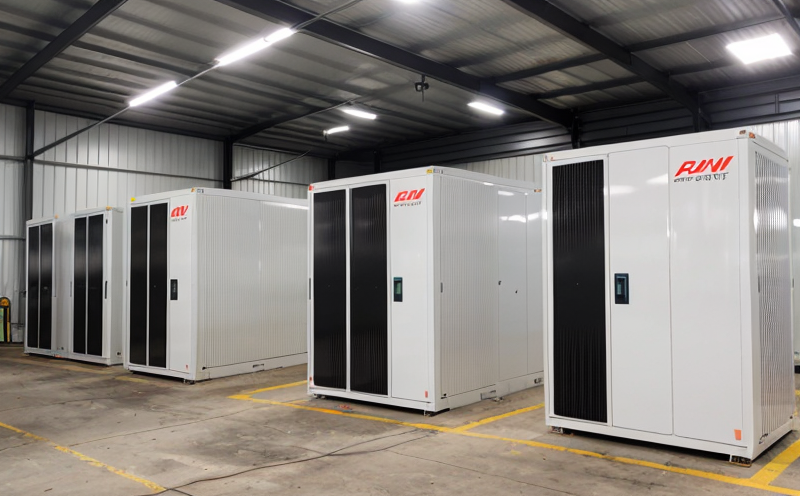IEC 62133-1 Safety Testing of Portable Sealed Secondary Batteries
The International Electrotechnical Commission (IEC) standard, IEC 62133-1:2017, specifies the safety requirements for portable sealed secondary batteries used in consumer electronics and similar applications. This standard is crucial for ensuring that portable battery systems are safe to use, transport, and store, thereby protecting consumers from potential hazards such as fire, explosion, or leakage.
Portable sealed secondary batteries encompass rechargeable batteries like lithium-ion (Li-ion), nickel-metal hydride (NiMH), and other similar chemistries. These batteries power a wide range of devices including cellular phones, laptops, digital cameras, and portable medical equipment. The IEC 62133-1 standard covers the safety aspects such as thermal stability, mechanical integrity, electrical integrity, and leakage prevention.
The testing procedures outlined in this standard are designed to simulate real-world conditions that might stress a battery beyond its normal operating range. This includes overcharging, overdischarging, short-circuiting, vibration, drop tests, puncture tests, heating under pressure, and more. The results of these tests provide assurance that the batteries meet stringent safety criteria set by international standards.
The testing process involves both electrical and mechanical evaluations to ensure compliance with IEC 62133-1. Electrical tests focus on verifying the battery's ability to withstand overvoltage conditions, while mechanical tests assess the structural integrity of the battery under various stresses. Compliance is determined based on specific pass/fail criteria detailed within the standard.
Compliance testing for this standard typically involves laboratory-grade equipment such as programmable charging stations, high-precision load testers, vibration platforms, and environmental chambers capable of simulating temperature extremes and pressure changes. Specimen preparation includes ensuring that batteries are in a fully charged state before undergoing mechanical stress tests like drop or puncture.
The testing procedures outlined in IEC 62133-1 are critical for manufacturers aiming to ensure product safety, meet regulatory requirements, and safeguard end-users from potential hazards associated with improper battery handling. By adhering to these stringent standards, companies can enhance their reputation for reliability and quality assurance.
Applied Standards
The primary standard applied in the testing of portable sealed secondary batteries is IEC 62133-1:2017. This standard incorporates various aspects of safety and performance that are essential for portable battery systems. It ensures that batteries meet rigorous requirements concerning electrical integrity, mechanical stability, and thermal management.
Other related standards include ISO/IEC 8846-3, which specifies the general principles for the design, manufacture, and use of rechargeable batteries; ASTM G178, which sets guidelines for evaluating battery safety during abuse testing; and UL 2580, which provides additional requirements for lithium-ion cells.
The combination of these standards ensures a comprehensive approach to ensuring the safety and performance of portable sealed secondary batteries. Compliance with these standards helps manufacturers meet regulatory requirements and build trust with customers by demonstrating adherence to industry best practices.
Industry Applications
| Application Area | Description |
|---|---|
| Consumer Electronics | Batteries for smartphones, tablets, and other personal devices. |
| Medical Devices | Patient monitoring systems and portable diagnostic tools. |
| Telecommunications | Rewritable optical disks (CD-RW, DVD-RW). |
| Transportation | Lithium-ion batteries for electric vehicles. |
- Smartphones and tablets are ubiquitous in modern society, requiring reliable battery performance to ensure continuous operation.
- In the medical field, portable devices must operate safely without risk of malfunction or failure, especially during critical procedures.
- The telecommunications industry relies on rewritable optical disks for data storage and retrieval.
- For transportation, lithium-ion batteries are essential for electric vehicle propulsion systems to enhance environmental sustainability.
These applications highlight the importance of thorough testing to ensure that portable sealed secondary batteries meet stringent safety standards. By doing so, manufacturers can provide products that are reliable, safe, and fit for purpose in diverse environments.
International Acceptance and Recognition
The IEC 62133-1 standard enjoys widespread acceptance and recognition across the globe. Countries around the world have adopted this standard to ensure that portable sealed secondary batteries are safe for use, transport, and storage.
Regulatory bodies in various countries, including the United States (UL), Canada (CSA), Japan (JIS), and Europe (EN 62133-1), recognize IEC standards as authoritative sources for safety requirements. Compliance with these standards is often a prerequisite for product certification and market entry.
Manufacturers who adhere to IEC 62133-1 not only meet regulatory requirements but also demonstrate their commitment to quality and safety. This is particularly important in industries where consumer trust and product reliability are paramount, such as medical devices and transportation systems.





